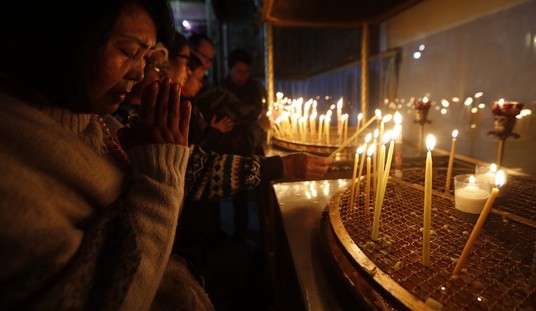I was interviewed Wednesday, January 3, 2018 about the ongoing demonstrations in Iran by Audrey Russo. Please listen to the full interview (approx. 12 minutes) here.
In the interview, I elaborated on why these nationwide demonstrations differ, dramatically, from what I have come to refer to as the 2009 “Soylent” Green Movement (with deliberate reference to the ghoulish theme of the Charlton Heston cult classic, and Edward G. Robinson’s final movie, Soylent Green).
The Green Movement’s chief ideologues — political leader Mir Hossein Mousavi and “spiritual guiding force” Ayatollah Montazeri (d. 2009) — were both full-throated, bigoted Shiite Sharia supremacists, who were pro-Iranian nukes (Mousavi helped godfather Iran’s nuke program; Montazeri affirmed it till his death in December, 2009), virulently anti-Western, and anti-“infidel.” Each also, sadly, championed Iran’s annihilationist, Shiite Islamic Jew-hatred. Ayatollah Montazeri, to his unique, and lasting shame, was the main contemporary Iranian clerical “revivalist” of the odious Shiite doctrine of najis. The doctrine dehumanizes non-Muslims as physically, politically, and spiritually “impure,” and in Iran has historically, through the present, made their very existence parlous.
Indeed, as I also pointed out during the interview, the elections of Rouhani in 2013 and 2017 represents the triumph of the Soylent Green ideology because Rouhani shares the views of Mousavi and Ayatollah Montazeri. As Iranian journalist Borzou Daragahi acknowledged in a January 3, 2018 essay, even amongst Iranian youth, “many of those who took to the streets in the 2009 ‘Green’ uprising … are sitting these protests out. They stood in long lines in 2013 and 2017 to elect Rouhani.”
Why might they be sitting out these protests? Unlike in 2009, the current protests are revolutionary.
They are directed at uprooting the entire Shiite theocratic system that was Iran’s form of governance (notwithstanding invasion and internal conflict in the 18th Century) from its founding by Shah Ismail in 1501 through 1925. Iran underwent a forced secularization/Westernization under the authoritarian Pahlavi Shahs from 1925 until 1979. The return of Shiite theocratic rule upon Khomeini’s ascension to power through his retrograde “revolution” had restored the theocratic norms of the 16th through the early 20th Centuries.
What were those (i.e., 1501-1925) “norms?” As characterized by the renowned Persianophilic scholar E.G. Browne in 1924: “The Mujtahids [an eminent, very learned Muslim jurist/scholar who is qualified to interpret the law] and Mulla [a scholar, not of Mujtahid stature] are a great force in Persia and concern themselves with every department of human activity from the minutest detail of personal purification to the largest issues of politics.”
It is precisely those Shiite theocratic norms the current protesters — and not their 2009 Soylent Green Movement counterparts — resoundingly reject, as illustrated below in three powerful examples (which I posted on my Twitter account):
[I] The demonstrators’ “Nine Key Demands,” put forth in the public domain;
[II] A revealing twitter exchange between a young Iranian woman Soylent Green Movement supporter, cool to the current protests, and a young Iranian man who supports them;
[III] The courageous, pellucid analysis of a young Iranian woman — a conscientious objector to Islam/“apostate” — describing her optimism about the present developments, and what they mean for her and all Iranians.
The “Nine Key Demands” feature (see, 1-3, 5, and 9), unabashedly, the dismantling of the Shiite theocratic state:
1) A referendum on founding the future regime, as most of the demonstrators called for a republican system similar to the developed countries and the overthrowing of the rule of the Faqih.
2) Undermining the ideology of the Faqih regime, and the liberation of Iranian society from the illusion of leadership of the Shiite world and its incursion into the Islamic world, and eliminate the slogan of exporting the revolution.
3) Abolishing the forced veil and endorsing the principle of women’s free choice of appearance and clothing.
4) Freedom of the media, including free access to information, the Internet, social networks and the abolition of censorship.
5) Separating religion from politics and removing religious institutions and estates from politics, handing the administration of state affairs over to a government of technocrats.
6) An independent, just and impartial judiciary that is not subjected to any authority, power, or political current.
7) Equal distribution of wealth and development plans to eradicate poverty, unemployment, and deprivation.
8) Free, fair, and transparent elections under international supervision.
9) Equality between women and men and the rejecting all forms of discrimination, violence, and abuse against women in all fields.
A Twitter exchange between two young Iranians elucidates the starkly different aspirations between young supporters of the 2009 Soylent Green Movement and the ongoing protests. What is further revealing is how the Green Movement protesters, overridingly “champions” of the Shiite theocratic status quo — who advocated at best dishonest tinkering “reforms,” as embodied by their twice-elected leader, Rouhani – now feel threatened by the truly revolutionary goals of those protesting now:
[Young woman] “A young Iranian who was active during the 2009 so-called Green Movement tells me it’s not our crowd this time around. These are lower income protesters. We don’t necessarily feel good about them either”
[Young man, respondent] “It’s correct that so-called green movement supporter[s] and so-called reformist[s] prefer to keep [their] distance from [the] current protests, because [the] current protests, unlike 2009, target [the] whole system, and regime.”
Finally, these piercing observations of a young Iranian woman “apostate” capture the pent-up yearning for true freedom — antithetical to the stultifying physical, social, and intellectual Shiite Islamic supremacist order — these demonstrations have come to represent for her:
I am very optimistic and hopeful because as an atheist, according to the laws of the [mainstream Shiite] Islamic Republic, which are based on Sharia, I am considered an apostate, and an infidel, and my blood is halal [i.e., taking her blood, and killing her is sanctioned]. It has been 39 years that no one, absolutely no one, other than the Shias have been in control because the most important qualification for them is belief in governance of the [Shiite] jurist, and Islam, and not the ability and knowledge of people.
How many more generations should be deprived of freedom and the pleasures of life? Iran will never become like Syria since the cause of the misery of people in Syria, and their condition is Islam [their Islamic Republic] itself.
Let us all hope her brave and righteous vision for a truly free Iran at long last prevails.









Join the conversation as a VIP Member